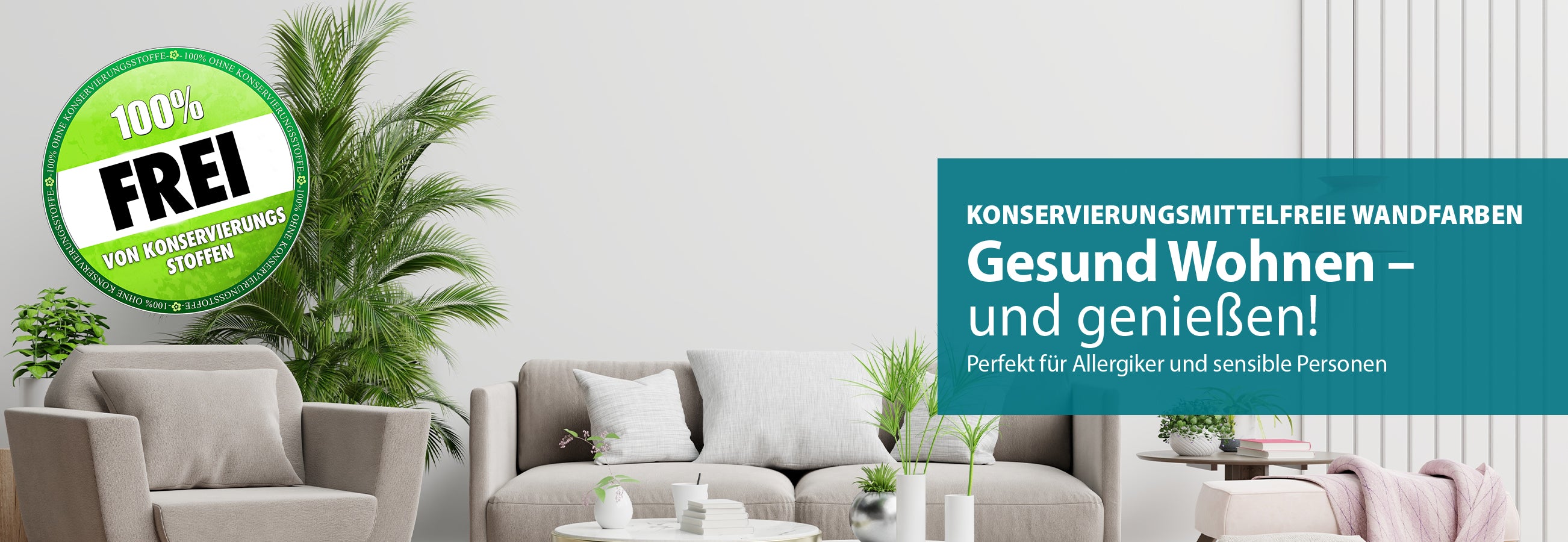wall paint without preservatives
Contents
All about wall paint without preservatives
Why are preservatives concerning and which ones are there?
Are paints with the "Blue Angel" label safe?
Benefits of preservative-free wall paint
Coverage of preservative-free wall paint
Wall paint without preservatives – how do manufacturers do it?
subheading
Everything about wall paint without preservatives
Wall paints are now available on the market with and without preservatives. Wall paints with preservatives have been criticized for some time because they are said to have a negative impact on health. In particular, the biocide isothiazolinone in emulsion paints, which is found in many paints as methylchloroisothiazolinone (MCI) or methylisothiazolinone (MI), is criticized in this context.
Consumers are often unsure about the color they choose and wonder how harmful the paint is for interior spaces. We want to explain the topic to you below and take away some of your worries so that you don't have to go without a new coat of paint in your home.
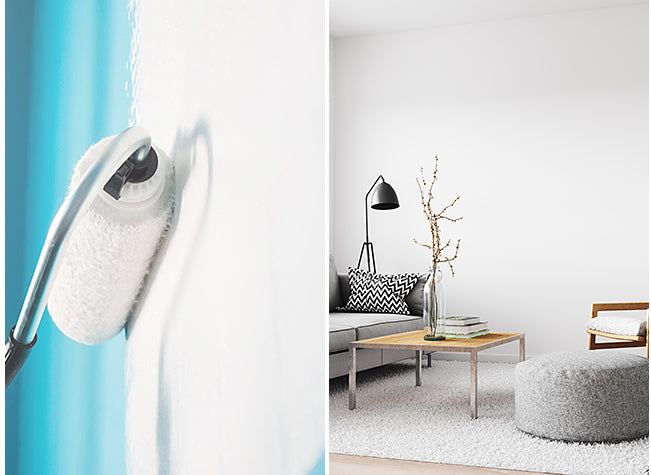
subheading
What are preservatives?
Preservatives are antimicrobial biocides that kill microorganisms or prevent their spread. They are used in many areas, such as food production and the production of cosmetics. Here they increase the shelf life of the products. In paints, the preservatives have the task of warding off pests during a coat of paint and preventing mold from forming on the walls. Many years ago, solvents were still added to wall paints. With the solvents, the paints did not need any additional preservatives. Today, emulsion paints are no longer solvent-based, but water-based, which is why interior paint can quickly become a breeding ground for bacteria and mold. This is why biocides such as isothiazolinones are used. However, the ingredients cause an allergic reaction, especially in sensitive people and allergy sufferers, which is why the preservatives must be declared on the containers.
What makes preservatives so questionable and which ones are there?
There are a number of preservatives that are permitted and some that are not. Isothiazolinones are permitted preservatives and are not only found in wall paints. They are also found in cosmetics such as shampoos, household cleaners and packaging materials. Wall paints with the "Blue Angel" seal of approval may not be enriched with them. According to the criteria, emulsion paints with the seal of approval must be completely free of harmful substances and formaldehyde.
Many people today are allergic to isothiazolinones. The number has increased in recent years, but according to a study, this is closely linked to the switch in the cosmetics industry from parabens to isothiazolinones as preservatives. Shampoos, shower gels and cleaning products contain the compounds and thus bring many people into direct skin contact with the preservative. According to estimates by the "Information Network of Dermatological Clinics" (IVDK), fewer than one in 1,000 people in Germany are allergic to methylisothiazolinone, which is found in interior paints. Whether an allergic reaction occurs varies from person to person, but statistically it is very rare.
As already mentioned at the beginning, there are different connections:
- chloromethylisothiazolinone
- Methylisothiazolinone (MIT, MI)
- Benzisothiazolinone (BIT) and - less well known:
- Octylisothiazolinone (OIT,OI)
- Dichlorooctylisothiazolinone (DCOIT, DCPOI)
- Butylbenzisothiazolinone (BBIT)
In general, isothiazolinones are used in wall paints only in the smallest possible quantities - just enough to ensure the antimicrobial effect. Legal limits and declarations ensure protection for humans. The preservatives certainly have their purpose in interior paints. Since there is usually no prolonged skin contact , most people do not have an allergic reaction. You can therefore use the paints for painting without any concerns. In case of doubt, however, there is a very simple solution: use preservative-free wall paint. Our BAUFIX painter's room white preservative-free, for example, has already been tested as a highly opaque emulsion paint with awarded the “Blue Angel” seal of quality.
subheading
Are wall paints with the “Blue Angel” seal safe?
New guidelines regarding the environmental seal have been in force since 2020. While not so long ago it was possible to add small amounts of preservatives to wall paints with the seal, this is no longer the case. Likewise, no solvents, plasticizers or formaldehyde may be included. Wall paints without the seal of approval must indicate that they contain preservatives.
and list them in the ingredients. "May cause allergic reactions" is one such warning. If you are allergic to isothiazolinone, you should always use preservative-free wall paints. Note: According to the Biocide Regulation, harmful substances such as boron compounds, boric acid and borax are prohibited in all wall paints. The same applies to silver ions.
subheading
Preservative-free emulsion paints have a number of advantages, especially for sensitive people. The interior paint does not pollute the air in the room. Whether during painting or after, there is hardly any odor when working with the preservative-free paint, so that the air in the room remains pleasant. This is a big step towards health safety. Good quality indoor air is particularly important when renovating in
Areas such as children's rooms, bedrooms and living rooms where you spend a lot of time should be taken into account. The preservative-free paint, which is low in emissions and pollutants, is ideal for use here for renovation. The paint free of preservatives is also suitable for indoor public spaces.
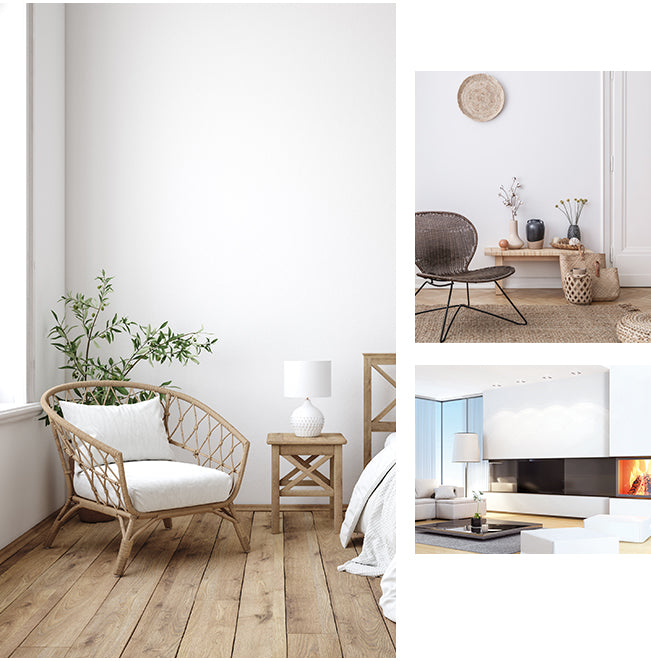
subheading
opacity of preservative-free wall paint
The opacity of interior paints, including preservative-free emulsion paints, is divided into opacity classes. The opacity classes show you how high the opacity of wall paint is. The opacity is legally defined in the DIN standard EN13300.
- Opacity of opacity class 4: contrast ratio less than 95%
- Opacity of opacity class 3: contrast ratio between 95% and 98%
- Opacity of opacity class 2: contrast ratio between 98% and 99.5%
- Opacity of opacity class 1: contrast ratio greater than or equal to 99.5%
If you plan to paint your wall in just one coat, you should use at least an opacity of 2, like with our preservative-free BAUFIX painter's room white. You can find opacity 1 in the preservative-free BAUFIX Ultra covering paint and BAUFIX professional Premium crystal white preservative-free.
The opacity of formulations containing preservatives as well as of low-emission and plasticizer-free emulsion paints depends on the class in which they are manufactured.
The only difference is that the durability of the wall paint is shorter compared to a wall paint with preservatives.
subheading
Wall paint without preservatives – how do manufacturers do it?
Instead of using preservatives, manufacturers of wall paints without preservatives use a high pH value of 11.3. The recipes are designed to fight bacteria and mold. The ingredients must be well matched to one another, as not every ingredient can tolerate a high pH value. An example of a paint with a high pH value is lime paint.
What should you keep in mind when painting walls?
When painting, make sure that the room is well ventilated so that the air in the room remains of a consistent quality. Even if paints without preservatives do not emit gases, they still ensure good air in the room when drying. If you use paint with preservatives, ventilate the room well every day for about a week and avoid skin contact. Wear painter's clothing and protect your hands sufficiently. You can also wear eye and mouth protection. This will provide adequate protection against splashes and odors.
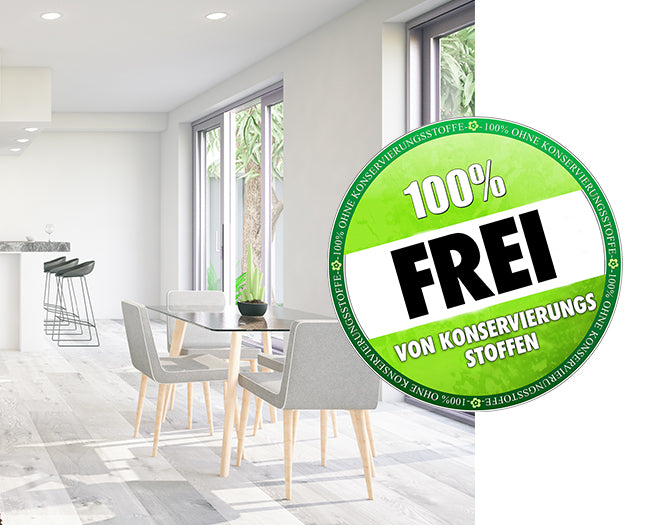
subheading
Recommendations for wall paints without preservatives
Make it easy for yourself and use BAUFIX solutions. Our BAUFIX painter's room white is a preservative-free emulsion paint that is ideal for interior walls and ceilings thanks to its breathable properties and high coverage. The silky matt shimmer and high degree of whiteness create a cozy and healthy living atmosphere and room air. You can use it to easily paint mineral surfaces such as masonry, concrete, plaster, building boards and wallpaper. You can achieve an extremely high degree of coverage with the BAUFIX Ultra covering paint without preservatives. The BAUFIX professional Premium crystal white without preservatives is resistant to abrasion when painted and also shows its ability on all mineral surfaces as well as building boards, wallpaper and old paintwork. Do you have any questions or would you like advice? We would be happy to help you and find the perfect solution for your healthy living project.
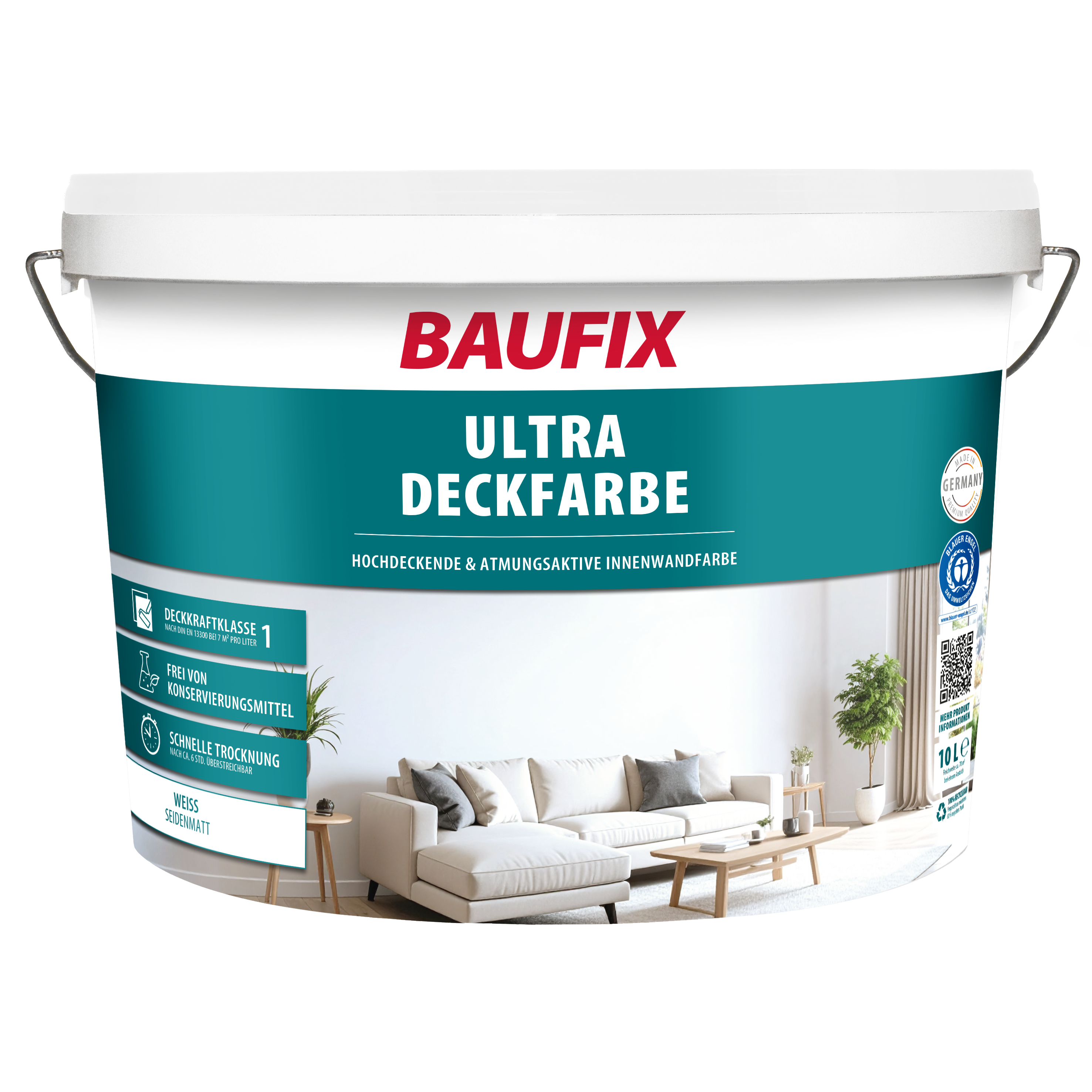
subheading
Our wall paint: BAUFIX Ultra-Deckfarbe
- Coverage class I according to DIN EN 13300 at 7 m²/l
- Wet abrasion resistance class III according to DIN EN 13300
- pearl white satin finish
- covers perfectly
- low-emission
- for walls & ceilings indoors

